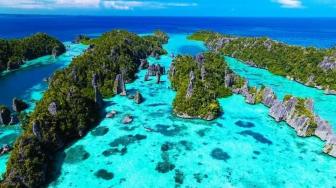TheIndonesia.id - To protect its rich natural diversity, Indonesia has 51 national parks across its provinces, and the Ujung Kulon National Park (UNKP) is among some that are located in the island of Java – the Banten province, to be exact – and it is home to the world-famous Javan rhinoceros (Rhinoceros sondaicus).
The rich biodiversity, paired with diverse landscapes like hills, lowlands, mountain, beaches, and sea, make UNKP unique, and it was declared as the World Heritage Site by UNESCO in 1992.
The 122,956-hectare area consists of 78,619 hectares of land and 44,337 hectares of water, and the national park can be divided into three main areas, which are Ujung Kulon peninsula, Mount Honje, and Panaitan Island. They all are part of tertiary mountains, and the middle part of Ujung Kulon area was formed by limestone formation that has been covered with alluvial layer in the north and sandy rocks in the south.
According to its manual book, Ujung Kulon National Park is one of the natural forests in Java and is one of the very few area with vegetation profile that ranges from coastline to the top of tropical mountain.
It hosts more than 700 plants, and 57 of those are classified as rare.
The floras are then classified into four categories: lowland rainforest, primary forest, secondary forest, and coastal forest, and each category has its own unique plants.
The lowland rainforest is filled fig trees, rattan, Diospyros trees, tokbrai trees, and different ranges of palm trees.
Meanwhile, in the primary forest, the main feature is large trees with high canopy and more open forest floor. This includes Corypha trees, the Neesia altissima, and bay leaf trees.
The secondary forest ranges between the primary and coastal forests with crape myrtle being its most dominant feature.
And the Indian-almond and tamanu trees can be easily found in coastal forest – as well as giant pandan vegetations.
As for wildlife, the majority of faunas in Ujung Kulon National Park are rare animals, and while some of them freely roam the area, the others can only be heard.
The Javan rhinoceroses are among the rarest animal, and they are difficult to spot because they stay deep in the forest, and it’s estimated that only 75 of them currently live in the national park.
The Java rhinos are odd-toed ungulate, and they are also larger than the Sumatran rhinos (Dicerorhinus sumetrensis).
Banteng (Bos javanicus) is another protected and endangered animals in Ujung Kulon, and they are often found in Cibunar and Cidaon pastures. The male banteng is black while the female one is golden brown. Both have horns, but the ones in male banteng are larger and curved.
UNKP also lists the Javan gibbons as priority animals, and they are strictly protected. They live and hang in trees in primary forests, and they have short tail, gray fur, and black face.
Other exotic animals that inhabit the Ujung Kulon area are deer, rib-faced deer, mouse deer, langurs, surilis, long-tailed macaques, slow lorises, wild boars, leopards, dholes, jungle fowl, and saltwater crocodiles – among others.
Based on official record, there are also about 250 birds in Ujung Kulon, and most of the time, they are rarely seen because they live in the canopy. Some of them are hornbills, sea eagles, green peafowl, Javan kingfishers, emerald doves, black drongos, and magpie robins.
The coastal ecosystem in UKNP is just as equally important as the forests, with rocky shores, swamps, mangroves, muddy lands, seaweed, coral reefs, and sea lanes.
The Ujung Kulon National Park is one of the backbones to help Indonesia to preserve its rich biodiversity. While there have been threats to forests and the environment at large, the country needs to ensure that the national park, and all floras and fauns that live in it, remain protected.








